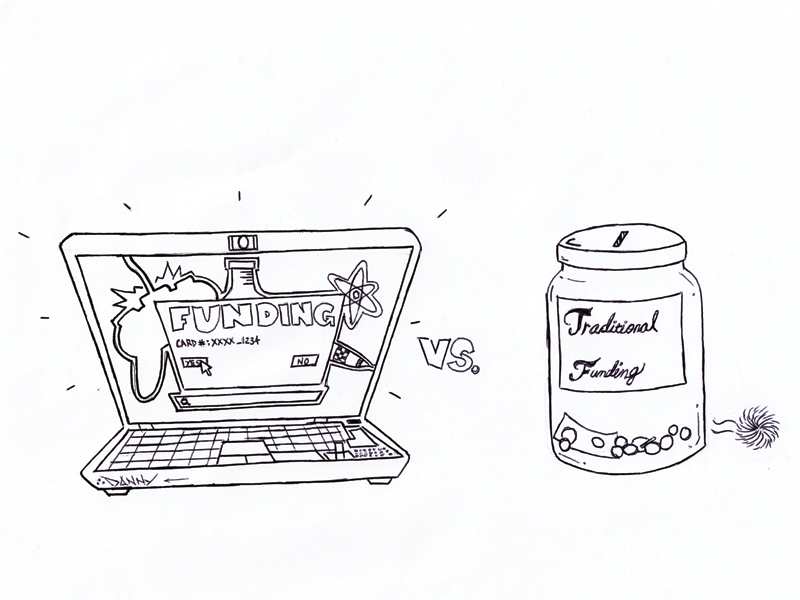
With the advent of the Internet and its increasingly cheaper costs and user-friendly interfaces, it should come as no surprise that many businesses are allowing the consumer the ability to influence the directions some companies go in. This same attitude of consumer empowerment has led to the creation of several highly successful crowdfunding sites where consumers are given the ability to subsidize the production of goods and services they want to see in the marketplace. While this system has had mixed success in financing new products, does the ability to succeed without traditional funding sources mean that scientific research is viable using the same system?
The answer is both a yes and a no.
For scientists Alex Piel and Edward Miracco, this new idea has already proven fruitful, raising them $9,055 for chimpanzee research and $6,215 for the extended use of an electron microscope. However, while these two succeeded in funding their projects, there’s much more to their successes than appears on the surface. For instance, most of the 37 donors to Miracco’s campaign were his family and friends. This leaves very little raised by everybody else through experiment.com, a crowdfunding website designed specifically for scientific research.
Miracco and Piel’s successful fundraising efforts are also extremely small when compared to the final tally of cash pledged to other projects. In the realm of consumer and entertainment-based patronage, numbers have risen as high as $10 million for the Pebble watch, $5 million for a “Veronica Mars” film and $4.5 million for the startup data-mining company Bitvore.
More than the price tag, though, what separates the aforementioned projects from anything a small research team of scientists (or even a large one for that matter) could provide to donors is the possibility of a tangible and consumable product or service. Without the incentive of a donor being eventually able to buy the product they helped fund, much of the motivation is lost, regardless of the long-term benefits these projects may yield. Furthermore, it’s much more difficult to promise donation perks for donors to the campaign. These scientists are already low on funds, whereas other projects offer such benefits as early access to the product and sometimes a behind-the-scenes look at what that donation is doing.
Aside from the nonconsumption nature of scientific campaigns, there is an additional lack of celebrity — whose presence in other campaigns more often than not drives people to open their wallets. With the previously mentioned “Veronica Mars” film, there was already a fanbase who had a desire to see the film made and was familiar with the characters and the actors who played them. The same can be said for Zach Braff’s film “Wish I Was Here,” whose $3 million success was due largely to his notability as a celebrity and Internet following of over a million on Twitter.
Even game-based projects rely heavily upon the notability of a product developer’s name. Certain projects like the game “Mighty No. 9” held not only to the idea of reviving the Megaman style of game that Capcom had let go fallow, but that the game was being designed by Keiji Inafune, the man known as “the father of Megaman.” This project managed to raise more than three times its goal of $900,000.
Even amid people’s desires to support their heroes and the benefits fame brings to these projects, fundraising often shows itself to be more than a little lottery-based. Projects like the video game “To The Death” were said to come from the dream team creators of the “Call of Duty” standards of online multiplayer and gameplay, and the creative director of “God of War.” Unfortunately, even with these appeals to people’s name recognition, the project failed to raise more than a 10th of its $400,000 goal. Considering this, regardless of whether charismatic powerhouses like Bill Nye, Michio Kaku, or Neil deGrasse Tyson utilize their fame to support these campaigns, there is always the chance that the scientific enterprise will fail.
While it may seem that there is no hope for the publicly funded scientific research of the future, programs like UCLA Spark pave the way for what could bring these programs into the public eye. UCLA Spark is a crowdfunding site in the same manner as Kickstarter, Indiegogo, or Experiment, but utilizes the university’s connections with faculty, alumni and current students to get the projects it hosts the attention they need for funding.
While the independent nature of their research is often what leads these scientists to promote themselves on experiment.com, it still seems necessary that — at least in the near future or until the love affair with donating to celebrity dies down — programs like Spark be created at a wider range of campuses across the country. Eventually there may be a place for scientific discovery in the crowdfunded era of business, but in the interim between that time and the present, universities and the programs they have developed to gain funding are the best alternative, giving beneficiaries access to networks more interested in seeing the growth of research than the average Internet donor.








